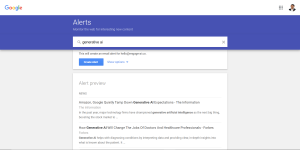In the dynamic world of artificial intelligence (AI), establishing trust is crucial. This trust is deeply rooted in transparent and accurate annotations, essential elements that define the effectiveness and reliability of AI systems. As we embark on a journey through the AI landscape, it becomes clear that annotations play an important role in shaping public confidence. They are key in various aspects, from machine learning training to enhancing AI transparency.
According to Forbes, the global AI market is experiencing a meteoric rise, projected to expand at a compound annual growth rate (CAGR) of 37.3% from 2023 to 2030, reaching a staggering $1,811.8 billion by the end of the decade. This incredible growth underscores the expanding role of AI in various sectors and the burgeoning importance of data annotation in this context.
In this article, we will explore how precise and clear annotations contribute to AI prominence, focusing on how they lead to more reliable AI. Our exploration will shed light on the intricate relationship between data annotation and the burgeoning trust in AI, underscoring the importance of annotation practices and the role of skilled teams of experts.
Importance of Trust in AI
Trust in AI is not just a nice-to-have; it’s a necessity. In a world increasingly reliant on AI solutions, the need for trustworthy systems cannot be overstated. Trust forms the bedrock of user acceptance and the widespread adoption of AI technologies. But what fuels this trust? At its core, trust in AI hinges on two key elements: AI transparency and annotation precision.
AI transparency is vital. When users understand how AI makes decisions, thanks to clear annotations, their confidence in these systems grows. Transparent decision-making processes are more likely to be trusted, as they allow users to see the ‘why’ and ‘how’ behind AI actions.
Equally important is annotation precision. Accurate annotations are critical in machine learning training, ensuring AI models learn from the best possible data. High-quality annotations lead to better, more accurate AI predictions and decisions, fostering trust among users.
In essence, trust in AI reflects how well these systems are understood and how accurately they can replicate or augment human decision-making. Through precise and transparent data handling, AI systems can earn the trust needed to be successfully integrated into our daily lives.
Overview of AI Annotations
AI annotations are the linchpins of machine learning, guiding AI systems in understanding and interpreting diverse data forms. This key process in machine learning training involves labeling various types of data – images, texts, sounds, and videos – equipping AI with the necessary insights to discern patterns and make informed decisions.
Historically, this process was largely manual. Data annotation was a labor-intensive task, where human annotators labeled data points, often leading to a slow and error-prone process. However, the advent of AI and ML systems has revolutionized this field. Today, as we explore further the data annotation trends, we see a significant shift towards more sophisticated, AI-driven methods. These advanced techniques not only enhance efficiency but also scale up the annotation process to meet the demands of complex AI models.
In AI development, there are four key types of data annotation:
- Image Annotations: In this type, elements within images are meticulously labeled, aiding visual recognition systems in accurately identifying and categorizing visual inputs.
- Text Annotations: Here, text is tagged to provide AI with deeper insights into language nuances and contexts, a fundamental aspect of effective natural language processing (NLP).
- Audio Annotations: Audio data is annotated to help AI recognize and interpret voice patterns and sounds, crucial for voice recognition and audio analysis.
- Video Annotations: Essential for motion recognition and analysis, video annotations involve tagging and tracking objects or actions within videos, providing contextual and temporal information to AI systems.
The accuracy of these annotations directly influences an AI’s performance, emphasizing the need for annotation precision. This is where specialized data labeling and annotation services play a significant role. They offer the expertise and resources required to handle, process, and ensure the relevance and accuracy of large datasets. These services are key in creating clear, understandable annotations for AI systems.
Moreover, these services often utilize a combination of automated tools and human expertise. Automation handles large volumes of data efficiently, while human annotators provide the necessary contextual understanding and precision.
Understanding the different types and complexities of AI annotations is crucial. It’s a challenging task, but it’s fundamental to building robust and reliable AI systems.
Annotations & Trust Building in AI

The manner in which data is annotated directly impacts AI’s learning efficiency and significantly shapes users’ trust in these systems. Effective annotations act as a crucial conduit, seamlessly connecting the intricate mechanics of AI with the transparency and comprehension essential for public trust. Now, let’s explore the key aspects of annotations and their vital role in fostering trust:
Transparency in AI Decision-making
Transparency in AI decision-making fosters trust by demystifying how AI systems reach conclusions. Through detailed annotations, users gain insights into the data processing and decision-making algorithms of AI. This is particularly vital in critical fields like healthcare, where understanding AI decisions can directly impact patient trust and treatment outcomes. Similarly, in financial services, transparent AI processes help mitigate risks and make informed decisions. As technology trends in financial services like AI, blockchain and big data analytics continue to evolve, ensuring transparency in these innovative tools is key to building consumer confidence while harnessing cutting-edge capabilities.
Ensuring AI Accuracy with Annotations
The accuracy of AI systems hinges significantly on the precision of annotations. In fields like autonomous vehicle technology, accurate annotations are essential for recognizing and responding to road conditions, pedestrian movements, and traffic signals. Similarly, in the realm of facial recognition, precise annotations help in improving recognition accuracy and reducing errors, which is crucial for security and personal identification applications.
Consistency in AI Performance
Consistent annotations ensure uniform AI performance across various applications. In e-commerce, for instance, consistent annotations in product categorization help improve search accuracy and customer experience. In language translation services, uniform annotations contribute to the accuracy and fluency of translated text, enhancing communication and reducing misunderstandings.
Challenges in Annotation Transparency & Accuracy
In the pursuit of clarity and precision in AI annotations, a range of challenges arises, pushing the limits of AI systems and their developers. These challenges test the robustness and flexibility of annotation processes in the face of ever-evolving AI demands.
Handling Massive Data
One significant challenge is managing the vast volumes of data required for AI training. Ensuring transparency and accuracy in such large datasets is a Herculean task. This involves not only the technical aspect of processing and storing this data but also maintaining quality control and consistency across all annotations. For example, in image recognition, the sheer number of images needing precise labeling can be overwhelming, requiring robust systems and meticulous processes.
Subjectivity and Bias in Annotations
Another hurdle is the inherent subjectivity and potential bias in human-annotated data. Human annotators, with their individual perceptions and understandings, can inadvertently introduce biases into the data, which the AI might then learn and replicate. This challenge is particularly evident in language processing, where cultural nuances and linguistic variations can lead to subjective interpretations.
Complexities of AI Privacy and Data Quality
The rise of AI technologies brings intricate challenges around data protection and informational privacy. The issues of defining and enforcing privacy in the context of AI make it a complex, abstract concept. This complexity is heightened in the realm of AI annotations, where maintaining data quality and adhering to privacy standards are paramount. Navigating these challenges requires a nuanced approach, balancing the need for detailed, accurate annotations with the ethical imperative to protect individual privacy.
Evolving Models & Continuous Annotation
Lastly, the evolving nature of AI models presents a continuous challenge. As these models develop and learn, the need for ongoing annotation becomes essential. This requires a dynamic approach to annotations, where data must be regularly reviewed and updated to keep pace with the AI’s evolution, ensuring its relevance and accuracy over time.
Best Practices in Transparent & Accurate Annotations
To address the challenges in annotation processes and enhance the overall quality and dependability of AI systems, certain best practices are essential.
Utilizing Automated Annotation Solutions
Automated annotation tools can greatly streamline the annotation process, particularly with large datasets. These solutions employ algorithms for initial data labeling, which human annotators can then refine. This blend of automation and human oversight balances efficiency and accuracy, enabling the efficient processing of vast data volumes while upholding high annotation quality. For example, in object recognition tasks, automated tools can detect basic shapes and objects, which human experts can subsequently verify and fine-tune.
Diverse Perspectives in Annotation
Bringing in diverse viewpoints in the annotation process is crucial to reduce bias and subjectivity. Engaging annotators from various backgrounds and areas of expertise makes the data more representative and less prone to individual biases. This approach is particularly significant in AI applications with global reach, where grasping cultural subtleties is key to accurate data interpretation.
Annotation Quality Assurance & Guidelines
Implementing rigorous quality control measures and establishing clear annotation guidelines are key to ensuring accuracy and uniformity in annotations. Regular audits and data reviews guarantee compliance with set standards. Moreover, providing thorough training for annotators and clear guidelines aids in standardizing the annotation process, thereby minimizing variability and inaccuracies in the data.
Use of Advanced Annotation Tools
Leveraging advanced annotation tools that offer features like auto-correction, context-based suggestions, and error flagging can significantly enhance the quality of annotations. These tools aid annotators in maintaining precision and consistency, especially in complex tasks like semantic segmentation or sentiment analysis.
Regular Training and Up-skilling of Annotators
Continuously training and up-skilling annotation teams is vital for keeping up with evolving AI models and annotation techniques. Regular workshops and training sessions ensure that annotators are adept at using the latest tools and are aware of the current best practices.
Implement Annotation Auditing by AI Experts
Having AI experts periodically audit the annotated data ensures a high level of expertise in the review process. These experts can provide insights into potential improvements and adjustments in the annotation process, based on the evolving needs of AI models.
Establish a Feedback Loop Between AI Developers and Annotators
Creating a feedback loop where annotators can communicate directly with AI developers helps in aligning the annotation process more closely with the specific requirements of AI models. This collaboration ensures that annotations are optimally tailored to the AI’s learning needs.
Ethical Considerations & Transparent Annotations
Ethical aspects are fundamental in the field of AI annotations, especially in maintaining openness and bolstering user confidence.
Respecting Data Privacy in Annotations
One of the foremost ethical considerations is respecting data privacy. When annotating sensitive data, such as personal information or private communications, it’s essential to anonymize data to protect individual privacy. This is especially important in medical or financial data annotation, where personal data security is paramount.
Fair Representation in Data Sets
Ensuring that data sets are diverse and fairly represent different groups is vital. This helps in avoiding biases in AI algorithms that can lead to unfair or discriminatory outcomes. Inclusive data sets contribute to the development of AI systems that are equitable and unbiased.
Transparency in Data Source and Usage
Being transparent about where data comes from and how it’s used in AI models is essential for ethical annotations. Users and contributors should be informed about the purpose and application of their data, fostering an environment of trust and openness.
Accountability in Annotation Errors
Establishing clear accountability for errors or biases in annotations is important. When annotation mistakes lead to errors in AI decision-making, it should be clear who is responsible for these errors, and there should be mechanisms in place for rectification and improvement.
Conclusion
In summary, the role of transparent and accurate annotations in AI cannot be overstated. They are critical in fostering user confidence and guaranteeing the ethical implementation of AI technologies. As we have explored, clear and exact annotations contribute significantly to demystifying AI decision-making processes, improving the accuracy of AI models, and ensuring consistent AI performance, all while addressing the challenges posed by massive data, subjectivity, and the continual evolution of AI.
The best practices in annotation, including the utilization of advanced tools, embracing diverse perspectives, and maintaining rigorous quality standards, are essential for upholding the integrity of AI systems. Moreover, adhering to ethical principles in data annotation ensures the respectful and fair treatment of all data, promoting trust and accountability in AI applications.
As AI continues to develop and become more integral in various aspects of our lives, the importance of upholding high standards in data annotation will only increase. It’s a collective endeavor involving developers, annotators, ethicists, and end-users, all working towards the shared objective of creating AI systems that are intelligent, efficient, trusted, and ethical.








